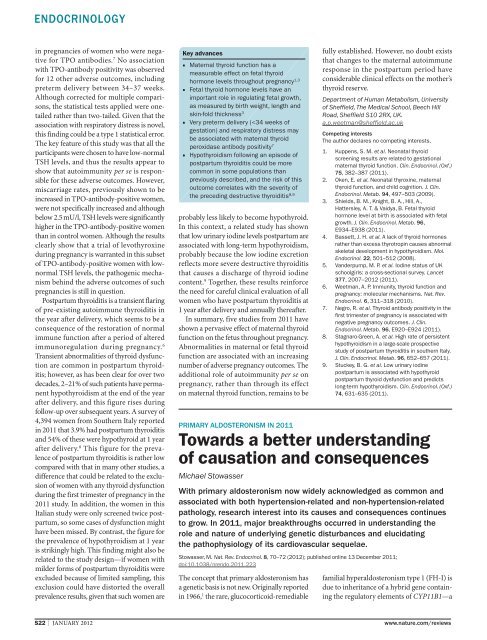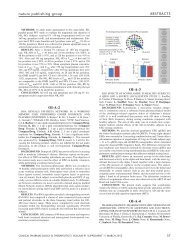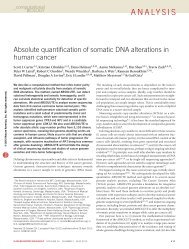open access: Nature Reviews: Key Advances in Medicine
open access: Nature Reviews: Key Advances in Medicine
open access: Nature Reviews: Key Advances in Medicine
Create successful ePaper yourself
Turn your PDF publications into a flip-book with our unique Google optimized e-Paper software.
ENDOCRINOLOGY<br />
<strong>in</strong> pregnancies of women who were negative<br />
for TPO antibodies. 7 No association<br />
with TPO-antibody positivity was observed<br />
for 12 other adverse outcomes, <strong>in</strong>clud<strong>in</strong>g<br />
preterm delivery between 34–37 weeks.<br />
Although corrected for multiple comparisons,<br />
the statistical tests applied were onetailed<br />
rather than two-tailed. Given that the<br />
association with respiratory distress is novel,<br />
this f<strong>in</strong>d<strong>in</strong>g could be a type 1 statis tical error.<br />
The key feature of this study was that all the<br />
par ticipants were chosen to have low-normal<br />
TSH levels, and thus the results appear to<br />
show that autoimmunity per se is responsible<br />
for these adverse out comes. How ever,<br />
miscarriage rates, pre viously shown to be<br />
<strong>in</strong>creased <strong>in</strong> TPO-antibody-positive women,<br />
were not specifically <strong>in</strong>creased and although<br />
below 2.5 mU/l, TSH levels were significantly<br />
higher <strong>in</strong> the TPO-antibody-positive women<br />
than <strong>in</strong> control women. Although the results<br />
clearly show that a trial of levothyrox<strong>in</strong>e<br />
dur<strong>in</strong>g pregnancy is warranted <strong>in</strong> this subset<br />
of TPO-antibody-positive women with lownormal<br />
TSH levels, the pathogenic mechanism<br />
beh<strong>in</strong>d the adverse outcomes of such<br />
pregnancies is still <strong>in</strong> question.<br />
Postpartum thyroiditis is a transient flar<strong>in</strong>g<br />
of pre-exist<strong>in</strong>g autoimmune thyroidi tis <strong>in</strong><br />
the year after delivery, which seems to be a<br />
consequence of the restoration of nor mal<br />
immune function after a period of altered<br />
immuno regulation dur<strong>in</strong>g pregnancy. 6<br />
Tran sient abnormalities of thyroid dysfunction<br />
are common <strong>in</strong> postpartum thyroiditis;<br />
however, as has been clear for over two<br />
decades, 2–21% of such patients have permanent<br />
hypo thyroidism at the end of the year<br />
after delivery, and this figure rises dur<strong>in</strong>g<br />
follow-up over subsequent years. A survey of<br />
4,394 women from Southern Italy reported<br />
<strong>in</strong> 2011 that 3.9% had postpartum thyroiditis<br />
and 54% of these were hypo thyroid at 1 year<br />
after delivery. 8 This figure for the prevalence<br />
of post partum thyroiditis is rather low<br />
compared with that <strong>in</strong> many other studies, a<br />
difference that could be related to the exclusion<br />
of women with any thyroid dysfunction<br />
dur<strong>in</strong>g the first trimester of pregnancy <strong>in</strong> the<br />
2011 study. In addition, the women <strong>in</strong> this<br />
Italian study were only screened twice postpartum,<br />
so some cases of dysfunction might<br />
have been missed. By contrast, the figure for<br />
the prevalence of hypothyroidism at 1 year<br />
is strik<strong>in</strong>gly high. This f<strong>in</strong>d<strong>in</strong>g might also be<br />
related to the study design—if women with<br />
milder forms of postpartum thyroiditis were<br />
excluded because of limited sampl<strong>in</strong>g, this<br />
exclusion could have distorted the overall<br />
prevalence results, given that such women are<br />
<strong>Key</strong> advances<br />
■ Maternal thyroid function has a<br />
measurable effect on fetal thyroid<br />
hormone levels throughout pregnancy 1,3<br />
■ Fetal thyroid hormone levels have an<br />
important role <strong>in</strong> regulat<strong>in</strong>g fetal growth,<br />
as measured by birth weight, length and<br />
sk<strong>in</strong>-fold thickness 3<br />
■ Very preterm delivery (








